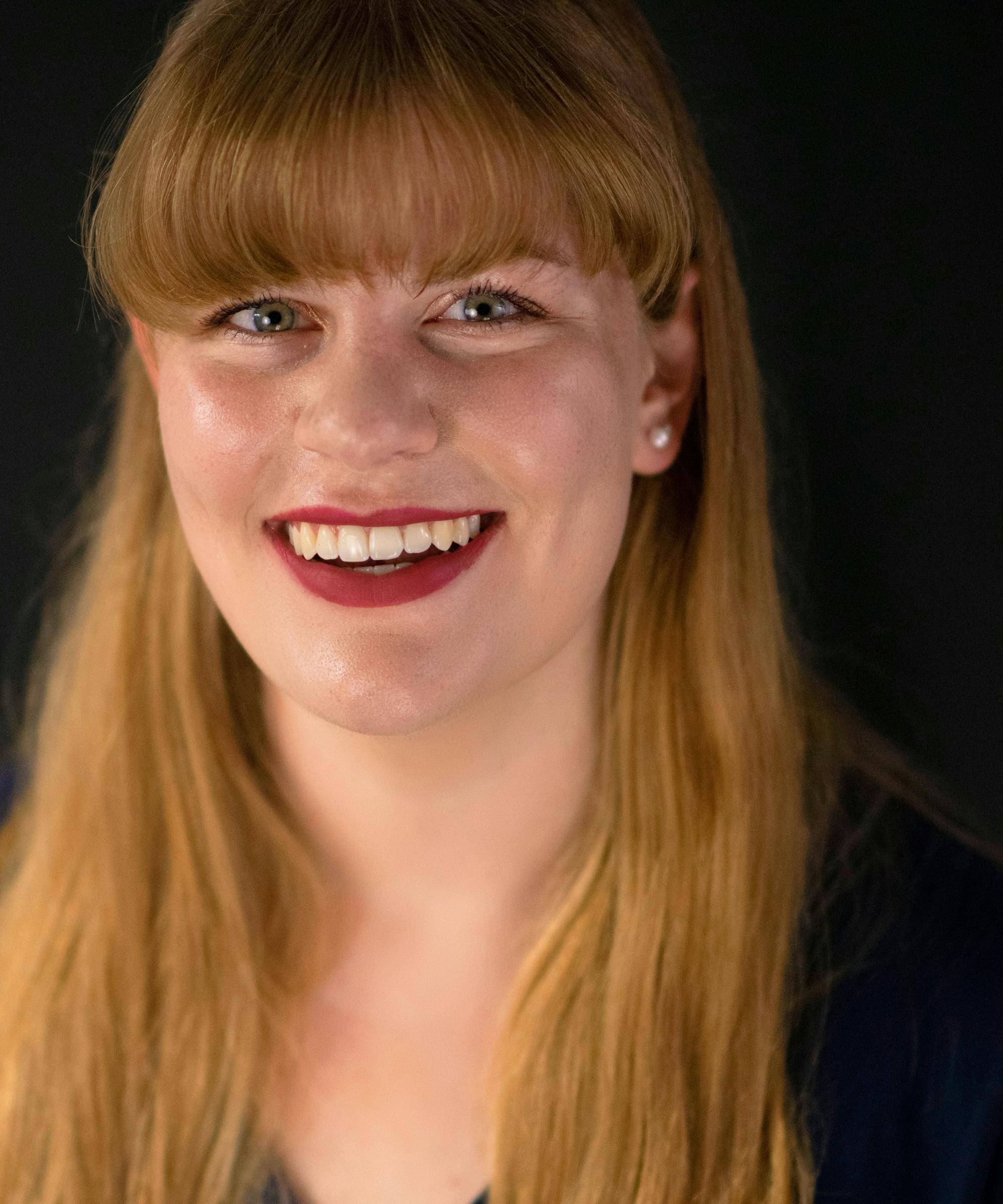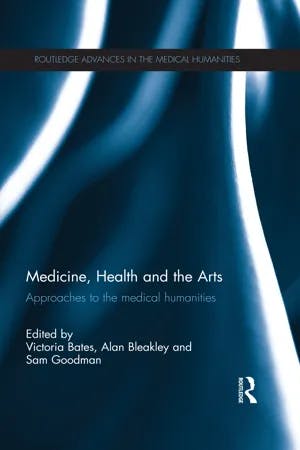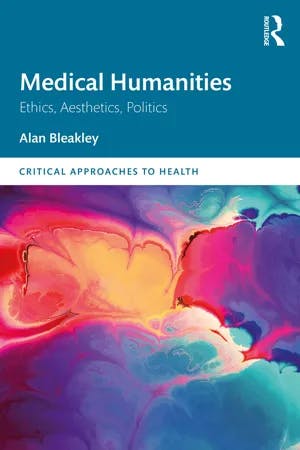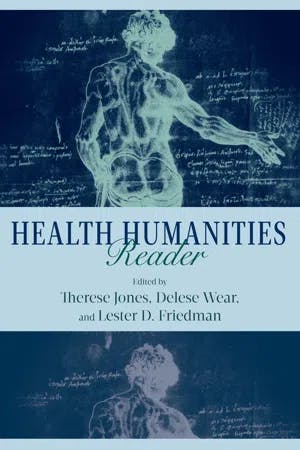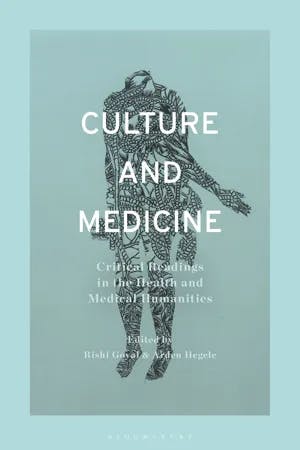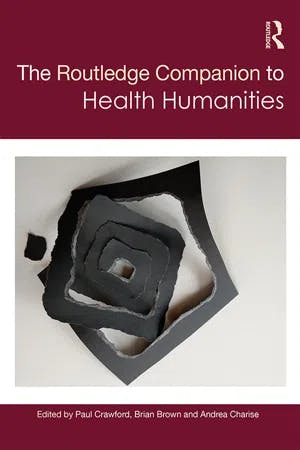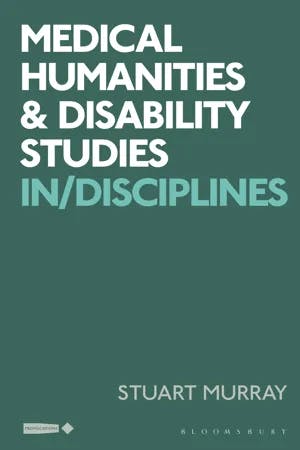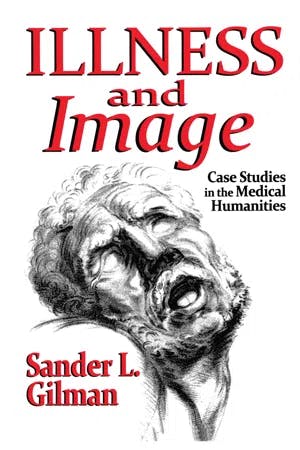What are the Medical Humanities?
MSt, Women's, Gender & Sexuality Studies (University of Oxford)
Date Published: 22.11.2023,
Last Updated: 22.11.2023
Share this article
Defining medical humanities
The medical humanities are a multidisciplinary field bridging approaches and perspectives from the humanities (including the arts and social sciences) with the study and experience of medicine, illness, and health. As Rinaldo F. Canalis, Massimo Ciavolella, and Valeria Finucci write, the medical humanities are
a hybrid area of study where the impact of disease and healing science on culture is assessed and expressed in the particular language of the disciplines concerned with the human experience. (2022)
Edited by Rinaldo F. Canalis, Massimo Ciavolella & Valeria Finucci
a hybrid area of study where the impact of disease and healing science on culture is assessed and expressed in the particular language of the disciplines concerned with the human experience. (2022)
Drawing upon literature, history, the arts, anthropology, philosophy, and more, the medical humanities investigate how disease, healing, and medicine influence culture, and how the humanities can inform medical care and education.
Alan Bleakley identifies “four contested and fragmented” areas of focus in the medical humanities:
- The humanities studying medicine: such as history of medicine or the critical evaluation of medicine in literature.
- Arts and humanities intersecting with medicine in medical education: ‘medicine as art’.
- Arts for health: for example, art in hospitals and arts activities with patients – often called ‘arts as medicine’.
- Arts therapies: sometimes linked with arts for health, but usually associated with mental health interventions using arts media within a psychotherapeutic framework. (“Toward a ‘critical medical humanities,’” in Medicine, Health and the Arts, 2013)
Edited by Victoria Bates, Alan Bleakley & Sam Goodman
- The humanities studying medicine: such as history of medicine or the critical evaluation of medicine in literature.
- Arts and humanities intersecting with medicine in medical education: ‘medicine as art’.
- Arts for health: for example, art in hospitals and arts activities with patients – often called ‘arts as medicine’.
- Arts therapies: sometimes linked with arts for health, but usually associated with mental health interventions using arts media within a psychotherapeutic framework. (“Toward a ‘critical medical humanities,’” in Medicine, Health and the Arts, 2013)
Examples of medical humanities projects include investigating historical medical practices related to pregnancy, analyzing depictions of tuberculosis in nineteenth-century literature, integrating visual art practice into therapy, and training doctors in literary skills and bioethics.
Because the medical humanities embrace such a range of methods and objects of study, defining the field, or even answering whether it is a proper “discipline,” can be challenging. For Bleakley, “‘the medical humanities’ is an inadequate collective term for a disparate set of approaches” (Routledge Handbook of the Medical Humanities, 2019). Victoria Bates and Sam Goodman note that the “question of whether the medical humanities is a ‘multidiscipline’, ‘interdiscipline’, ‘discipline’ or ‘field’ is by no means resolved”; in fact,
It is the malleability of the term ‘medical humanities’ that makes its definition so problematic and arguably even unnecessary; indeed, a clear-cut definition could remove the diversity of approach that makes the medical humanities so appealing in the first place. (Medicine, Health and the Arts, 2013)
In other words, the medical humanities avoid disciplinary boundaries and defining categories, even questioning the strict separation of arts and sciences. In recent decades, the field has taken an increasingly self-reflexive turn. The resulting “critical medical humanities” interrogate the very values, assumptions, and definitions underlying medicine and the humanities, inviting questions like: How is the concept of health influenced by normative values and historical trends? How do we balance trust in medical science and textbook techniques with trust in the patient’s experience?
The medical humanities not only propel important conversations in biomedicine (about ethics, identity, humanity, etc.) but also reveal how perspectives and methods associated with the humanities are already present in medicine. For example, doctors perform when they interact with patients; patients use metaphors to describe their experiences; medical illustrations, photographs, and charts engage in visual aesthetics.
For Bleakley, these aspects of medicine should be embraced through the medical humanities. Bleakley writes,
The medical humanities in clinical practice and medical education can be defined as the art of productively increasing the metaphor count. [...]. As the metaphor count rises, so the public body is “healthier” in the sense of increasing intensity, quality, and complexity of life. (2023)
Alan Bleakley
The medical humanities in clinical practice and medical education can be defined as the art of productively increasing the metaphor count. [...]. As the metaphor count rises, so the public body is “healthier” in the sense of increasing intensity, quality, and complexity of life. (2023)
A brief history of the medical humanities
The histories of humanism and medicine have been entwined since ancient times, when disciplines were not strictly separated and science was known as “natural philosophy.” Before the nineteenth century, scientific ideas were frequently expressed through poetry. The Victorians believed reading novels influenced one’s health — an unhealthy practice for already “emotional” young women, but potentially a restorative treatment for convalescent men (see Convalescence in the Nineteenth-Century Novel).
However, the true disciplinary roots of the medical humanities lie in the art therapy movement, born after World War II. In Art Versus Illness (1945), Adrian Hill documented the use of art when treating patients in a tuberculosis sanitorium. The term “medical humanities” was first coined in 1947 by George Sarton in Isis, founded as the official journal of the History of Science Society. In the 1950s, Case Western Reserve University introduced a history of medicine curriculum, and in 1967 the first Department of Humanities in any medical school was established at Pennsylvania State University’s College of Medicine.
Throughout the 1960s, medical schools expanded and increased biomedical research and clinical service, leading to decreased attention on fostering student values and growth. However, the next decade demanded a new approach:
With the 1970s came the emergence of seemingly miraculous but morally troubling medical and technological advances such as organ transplantation, standards of death, in vitro fertilization, and complex pharmaceuticals. Educators inserted humanities materials and methodologies into the medical curriculum and clinical practice with the intention of remedying the growing imbalance between the technological aspects of health care and the human aspects of caregiving [...]. (2014)
Edited by Therese Jones, Delese Wear & Lester D. Friedman
With the 1970s came the emergence of seemingly miraculous but morally troubling medical and technological advances such as organ transplantation, standards of death, in vitro fertilization, and complex pharmaceuticals. Educators inserted humanities materials and methodologies into the medical curriculum and clinical practice with the intention of remedying the growing imbalance between the technological aspects of health care and the human aspects of caregiving [...]. (2014)
These moral questions led to an interest in bioethics, from which medical humanities could fully take shape.
In the 1980s and 1990s, book and journal publications and formal conferences helped the medical humanities become accepted as a discipline. Since then, the field’s critical turn has focused less on establishing the discipline and more on interrogating the very terms on which it is founded.
For more, see the timeline in Medicine, Health and the Arts and Medical Humanities.
Medical humanities methods: examples in literature and narrative medicine
The scope of the medical humanities is broad, stretching across time periods, disciplines, and applications (education, treatment, research, etc.). To explore various focuses and applications, we recommend Medicine, Health and the Arts and the Routledge Handbook of the Medical Humanities.
Goyal and Hegele group projects in the medical humanities into three methodological categories. Here, we’ll explore these categories and consider examples in each related to the same topic: literature and the medical humanities.
Three methodological categories
The first group of studies “takes the medical and/or health humanities as a conceptual approach and applies it to a specific domain of humanities scholarship, such as history or literary studies” (Goyal and Hegel, 2022). These studies use methodologies born in the humanities to examine work at the intersection of the humanities and medicine. For example, Erika Wright’s Reading for the Health (2016) examines nineteenth-century literary works to theorize reading practices around the concept of health, focusing on how the prevention of illness and preservation of well-being operate structurally and thematically. Other examples of this methodological group related to literature include Sari Altschuler’s The Medical Imagination (2018); Esther L. Jones’ Medicine and Ethics in Black Women's Speculative Fiction (2016); and the two volumes of Literature and Medicine, The Eighteenth Century (2021) and The Nineteenth Century (2021).
The second group of studies “takes a reverse methodology by applying an analytical lens from the medical and health humanities to problems within medicine and healthcare” — for example, considering “the ethical status of physician empathy” (Goyal and Hegel, 2022). Medical humanities projects intersecting with bioethics are often in this category. Examples include Leslie Jamison’s The Empathy Exams (2014), Kate Polak’s Ethics in the Gutter: Empathy and Historical Fiction in Comics (2017), and Patrick Anderson’s Autobiography of a Disease (2017).
The third group of studies, “focused on pedagogical approaches, frames the medical and health humanities in their range of institutional contexts, whether in medical schools or humanities departments” (Goyal and Hegel, 2022). These studies consider how to teach the medical and health humanities, and how medical education can be improved through the medical humanities. Examples include Ronald Schleifer and Jerry B. Vannatta’s Literature and Medicine: A Practical and Pedagogical Guide (2019), John Salinsky’s Medicine and Literature: The Doctor's Companion to the Classics (2018), and Bleakley’s Educating Doctors' Senses Through The Medical Humanities (2020).
Narrative medicine
A significant offshoot of the medical humanities is narrative medicine, which works across these methodologies. Narrative medicine is a growing interdisciplinary field that recognizes the importance of storytelling to medicine. Narratives are embedded in medicine through the case history (the physician’s account of the patient’s condition) and the illness narrative (the sick person’s account of their own experience).
Rita Charon is a foundational figure in narrative medicine. In Stories Matter (2004), edited by Charon and Martha Montello, and Narrative Medicine (2008), Charon draws from various sources to argue that narratives can help doctors recognize patients and diseases, convey knowledge, serve their patients, and consider ethical questions.
While Charon speaks to medical ethics and medical practice, Ann Jurecic challenges literary theorists’ unwillingness to treat illness narratives as literature in Illness as Narrative (2012). Jurecic explores “how writers and readers use narratives of illness to make meaning of the experiences of living at risk, in prognosis, and in pain” and “how narratives of illness invite reflection about the purpose and future of literature, the arts, and literary criticism” (2012).
Other important texts in narrative medicine include The Wounded Storyteller (1995, [2013]) by Arthur W. Frank and Storytelling in Medicine (2023), edited by Colin Robertson and Gareth Clegg.
Why medical humanities? Debates in the field
What is the purpose of the medical humanities? On one level, the humanities can provide skills that are useful in medical contexts. For instance, literary skills like close reading and analysis can help a physician understand their patient’s story and interpret the signs of health and/or illness. As Joanne Trautmann Banks argues in “The Wonders of Literature in Medical Education” (1982), “‘to teach a student to read in the fullest sense is to train him or her medically.” She argues that the interpretive skills necessary for literary analysis and critical reading — noticing subtleties, ambiguities, details, and subtext; filling in gaps; understanding relationships; accounting for context — are all also necessary tools in medicine.
A related view sees the humanities as not only — even not primarily — instilling skills but rather providing a moral education. Studying the humanities helps medical students engage with “cultural perspectives on health and illness, social justice and the moral dimensions of patient encounters” (Jones, ‘Oh, the humanit(ies)!,’ Medicine, Health and the Arts, 2013). A similar view understands the humanities as encouraging empathy in physicians.
However, many medical humanists take issue with treating the humanities as a sort of moral cure for biomedicine. Increasing the ethical reasoning and empathic abilities of physicians is a worthy goal. However, the humanities are no quick fix. In Literature and Medicine: A Claim for a Discipline (1984), Anne Hudson Jones cautions against the assumption that studying the humanities necessarily makes one more humane:
This expectation makes me very uncomfortable. This expectation is a burden, not just for literature, for all of the humanities. We all hope that it will [make one more humane], but there have been too many examples to the contrary for me to believe in any guarantee. (Quoted in Jones, Wear, and Friedman, 2014)
For some medical humanists, approaching the humanities as a means to “soften” the “hard” science of biomedicine underestimates both the possibilities of the humanities and medicine. It downplays, as Jones writes,
the intellectual practice of the humanities with all of its democratizing energies and dangerous possibilities, which enable and promote fearless questioning of representations, challenges to the abuses of authority and a steadfast refusal to accept as the limits of enquiry the boundaries that medicine sets between biology and culture. (2013)
Esther L. Jones
the intellectual practice of the humanities with all of its democratizing energies and dangerous possibilities, which enable and promote fearless questioning of representations, challenges to the abuses of authority and a steadfast refusal to accept as the limits of enquiry the boundaries that medicine sets between biology and culture. (2013)
Bleakley argues that the medical humanities will prove an increasingly “democratizing force” that pushes medicine forward (Jones, Wear, and Friedman, 2014). Indeed, Bleakley argues against treating the humanities as “supposed compensation for science’s perceived lack”:
[...] without diluting the power of the arts and humanities to add important voices to medical and healthcare debates, what if we were to concentrate on releasing biomedical science from the long standing grip of reductionist values to allow it to express its worth through a range of values? (2023)
For Bleakley, the medical humanities “raise the aspirations of biomedical science from the instrumental to embrace a spectrum of values and qualities” (2023). Rather than taking for granted that medicine is unfeeling, impersonal, and detached, Bleakley sees the possibility for medicine to embrace sensibility and compassion; incorporate personal connections and context into treatment; and value different factors and practices. Although awakened through interaction with the humanities, this potential, Bleakley argues, exists within medicine itself.
Medical humanities vs. health humanities: a related but distinct field
The health humanities are the medical humanities' closest disciplinary cousin. Originally, “health humanities” was introduced as a more inclusive term meant to replace “medical humanities.” Emerging around 2007, the health humanities firmly established their own footing by 2015 and have since developed into their own field (Crawford, 2020).
As Rishi Goyal and Arden Hegele note, the medical and health humanities share core values:
These distinct but related fields recognize disease as a sociocultural and a biomedical phenomenon. They approach medicine through a critique of ideology, class, gender, and race-based assumptions with an appreciation for the constructive dimensions of language. The medical and health humanities denaturalize the biomedical sciences without diminishing their power to effect change in the physical and mental world of patients. (2022)
Edited by Rishi Goyal, Arden Hegele
These distinct but related fields recognize disease as a sociocultural and a biomedical phenomenon. They approach medicine through a critique of ideology, class, gender, and race-based assumptions with an appreciation for the constructive dimensions of language. The medical and health humanities denaturalize the biomedical sciences without diminishing their power to effect change in the physical and mental world of patients. (2022)
The health humanities differs from the medical humanities in intentionally extending beyond medicine strictly speaking to include broader conceptions of health and healthcare. As Paul Crawford et al. argue in Health Humanities (2015),
the majority of healthcare and the generation of health and well-being is non-medical. Despite being a popular activity, visits to the doctor, or doctor consultations in the clinic, are relatively fleeting. [...] In hospitals and residential settings clients may spend more time with care assistants, catering and cleaning staff, as well as informal and family carers, than they do with doctors. [...] Complementary, alternative healthcare and a strong shift to self-care and community-generated solutions give further notice that medicine and ‘medical humanities’ is too narrow a bandwidth for considering the contribution that arts and humanities can make to the mental health and well-being of society.
Edited by P. Crawford, B. Brown, C. Baker, V. Tischler & Brian Abrams
the majority of healthcare and the generation of health and well-being is non-medical. Despite being a popular activity, visits to the doctor, or doctor consultations in the clinic, are relatively fleeting. [...] In hospitals and residential settings clients may spend more time with care assistants, catering and cleaning staff, as well as informal and family carers, than they do with doctors. [...] Complementary, alternative healthcare and a strong shift to self-care and community-generated solutions give further notice that medicine and ‘medical humanities’ is too narrow a bandwidth for considering the contribution that arts and humanities can make to the mental health and well-being of society.
The health humanities challenge a bias in medicine that some argue pervades the medical humanities as well: the privileging of professional training over lived experience and lay perspectives. As Crawford writes in The Routledge Companion to Health Humanities,
The health humanities adopt an interdisciplinary, inclusive, applied, democratizing, and activist approach to the arts and humanities in informing and transforming health care, health, and well-being. [...] [I]t has fractured the expert to non-expert dynamic [...]. (“Introduction,” 2020)
Edited by Paul Crawford, Brian Brown & Andrea Charise
The health humanities adopt an interdisciplinary, inclusive, applied, democratizing, and activist approach to the arts and humanities in informing and transforming health care, health, and well-being. [...] [I]t has fractured the expert to non-expert dynamic [...]. (“Introduction,” 2020)
For Bleakley, the medical humanities focus on medical education, patient care, and the “academic, critical study of medical culture” while the health humanities focus on broader “health- and social-care education and practice spectrums” and the use of the arts for “therapeutic purposes through public participation” (2023). Health humanities are more often found in humanities spaces, while medical humanities can be found in more clinical settings.
Whatever the precise relationship between these terms, Crawford et al. argue that
the genetic code of the tradition called ‘medical humanities’ has been radically altered by the health humanities movement and ‘health humanities’ looks set to become the superordinate term for the application of arts and humanities to healthcare, health and well-being. This will bring new inclusions, new visions, and ultimately new kinds of society. (2015)
Interdisciplinary systems
The multidisciplinary medical humanities are open to intersections with other disciplines, fields, and approaches. For example, the critical medical humanities and the health humanities draw upon intersectional feminism, critical race theory, and — as the global reach of the medical humanities increases — postcolonialism. These perspectives shape questions about how medical systems treat specific communities, how communities of care differ across cultures, and how unhealthy conditions affect different demographics.
Disability studies, like the medical humanities, harnesses various disciplines to ask questions intersecting with health, illness, medicine, and the body. Disability studies considers how disability is constructed, experienced, and expressed, understanding the physical and mental realities of disabilities while critically considering which bodies and minds come to be considered “normal” and which “disabled” — and how and why that is (see our study guide on critical disability theory for more).
Stuart Murray’s Medical Humanities and Disability Studies (2023) specifically focuses on the overlap between these fields, how they approach questions of disability and the body, and what each field has to offer the other. Murray sees both fields as “systems,” as “networks of communication and assemblages of critical thought” (2023). The specific labels of these fields are less important than the questions they stimulate. Murray writes,
The fact that at this current moment in time parts of academia choose to frame scholarship in medicine, health and disability within certain terms is a passing phase. It will change and develop in years to come. What won’t change is the central role that medicine, health and disability have in people’s lives and to the social and cultural formations that surround them. I understand it to be the job of both Disability Studies and Medical Humanities to respond to these issues [...]. They bring philosophical concepts of selfhood into dialogue with personal experiences of bodily pain, for example, or theorize disabled embodiment as it helps inform systems of social health. (2023)
Stuart Murray
The fact that at this current moment in time parts of academia choose to frame scholarship in medicine, health and disability within certain terms is a passing phase. It will change and develop in years to come. What won’t change is the central role that medicine, health and disability have in people’s lives and to the social and cultural formations that surround them. I understand it to be the job of both Disability Studies and Medical Humanities to respond to these issues [...]. They bring philosophical concepts of selfhood into dialogue with personal experiences of bodily pain, for example, or theorize disabled embodiment as it helps inform systems of social health. (2023)
Another field with which the medical humanities has a productive partnership is the environmental humanities. Just as the medical humanities draw upon approaches from the humanities and social sciences to consider medicine, health, and disease, the environmental humanities do the same with questions of ecology and environmentalism. Scholars working within these fields explore the links between health and, for example, environmental precarity, natural disasters, and climate conditions (rising temperatures, pollution, lack of clean water). These questions reveal the metaphorical and literal connections between the health of humanity and the health of the planet.
Writing during the Covid-19 pandemic, Scott Slovic, Swarnalatha Rangarajan, and Vidya Sarveswaran argue that
there is no “human health” and “environmental health.” There is only health—and the absence of health. There is only precarity, experienced admittedly in variable degrees according to just and unjust social and economic systems, but an overarching and fundamental precarity that encompasses all of us, regardless of nationality and ethnicity and species. [...] [T]his public health crisis reinforced the urgency of yoking together scholarly traditions—the medical humanities and the environmental humanities—that had previously existed mostly in parallel but largely independent spaces. We anticipate that this will no longer be the case. (2023)
Edited by Scott Slovic, Swarnalatha Rangarajan & Vidya Sarveswaran
there is no “human health” and “environmental health.” There is only health—and the absence of health. There is only precarity, experienced admittedly in variable degrees according to just and unjust social and economic systems, but an overarching and fundamental precarity that encompasses all of us, regardless of nationality and ethnicity and species. [...] [T]his public health crisis reinforced the urgency of yoking together scholarly traditions—the medical humanities and the environmental humanities—that had previously existed mostly in parallel but largely independent spaces. We anticipate that this will no longer be the case. (2023)
The medical and health humanities are adaptable fields that incorporate various methodologies and address a range of factors related to health, medicine, disease, and more. As Sander L. Gilman writes,
The medical humanities are an acknowledgement that multiple perspectives can and do provide different and coherent approaches to complex and often contradictory questions beyond the traditional scope of the humanities. (2018)
Sander L. Gilman
The medical humanities are an acknowledgement that multiple perspectives can and do provide different and coherent approaches to complex and often contradictory questions beyond the traditional scope of the humanities. (2018)
Stretching beyond the traditional bounds of the humanities and the sciences, the medical and health humanities can help us address multi-faceted issues and come to novel conclusions.
Further reading on Perlego
The History of Medicine (2014) by Mark Jackson
Medical Humanities and Medical Education: How the medical humanities can shape better doctors (2015) by Alan Bleakley
Approaches to Art Therapy: Theory and Technique (2016) Judith Aron Rubin
New Directions in Literature and Medicine Studies (2017) by Stephanie M. Hilger
Medical Humanities in American Studies: Life Writing, Narrative Medicine, and the Power of Autobiography (2018) by Mita Banerjee
What are the medical humanities in simple terms?
What are the critical medical humanities?
What is the difference between the medical humanities and the health humanities?
What are examples of projects in the medical humanities?
Bibliography
Altschuler, S. (2018) The Medical Imagination: Literature and Health in the Early United States. University of Pennsylvania Press, Inc. Available at: https://www.perlego.com/book/732336/the-medical-imagination-literature-and-health-in-the-early-united-states-pdf
Anderson, P. (2017) Autobiography of a Disease. Routledge. Available at: https://www.perlego.com/book/1523977/autobiography-of-a-disease-pdf
Bates, V., Bleakley, A. and Goodman, S. (eds.) (2013) Medicine, Health and the Arts: Approaches to the Medical Humanities. Routledge. Available at: https://www.perlego.com/book/1678347/medicine-health-and-the-arts-approaches-to-the-medical-humanities-pdf
Bates, V. and Goodman, S. (2013) “Critical Conversations: Establishing Dialogue in the Medical Humanities,” in Bates, V., Bleakley, A. and Goodman, S. (eds.) Medicine, Health and the Arts: Approaches to the Medical Humanities. Routledge. Available at: https://www.perlego.com/book/1678347/medicine-health-and-the-arts-approaches-to-the-medical-humanities-pdf
Bleakley, A. (2013) “Towards a ‘Critical Medical Humanities,’” in Bates, V., Bleakley, A. and Goodman, S. (eds.) Medicine, Health and the Arts: Approaches to the Medical Humanities. Routledge. Available at: https://www.perlego.com/book/1678347/medicine-health-and-the-arts-approaches-to-the-medical-humanities-pdf
Bleakley, A. (ed.) (2019) Routledge Handbook of the Medical Humanities. Routledge. Available at: https://www.perlego.com/book/1547736/routledge-handbook-of-the-medical-humanities-pdf
Bleakley, A. (2020) Educating Doctors’ Senses Through The Medical Humanities: “How Do I Look?.” Routledge. Available at: https://www.perlego.com/book/1494310/educating-doctors-senses-through-the-medical-humanities-how-do-i-look-pdf
Bleakley, A. (2023) Medical Humanities: Ethics, Aesthetics, Politics. Routledge. Available at: https://www.perlego.com/book/4196916/medical-humanities-ethics-aesthetics-politics-pdf
Canalis, R., Ciavolella, M. and Finucci, V. (2022) Rethinking Medical Humanities: Perspectives from the Arts and Social Sciences. De Gruyter. Available at: https://www.perlego.com/book/3783107/rethinking-medical-humanities-perspectives-from-the-arts-and-the-social-sciences-pdf
Charon, R. and Montello, M. (eds.) (2004) Stories Matter: The Role of Narrative in Medical Ethics. Taylor and Francis. Available at: https://www.perlego.com/book/1611138/stories-matter-the-role-of-narrative-in-medical-ethics-pdf
Charon, R. (2008) Narrative Medicine: Honoring the Stories of Illness. Oxford University Press.
Crawford, P. et al. (2015) Health Humanities. Palgrave Macmillan UK. Available at: https://www.perlego.com/book/3483510/health-humanities-pdf
Crawford, P., Brown, B. and Charise, A. (eds.) (2020) The Routledge Companion to Health Humanities. Routledge. Available at: https://www.perlego.com/book/1507868/the-routledge-companion-to-health-humanities-pdf
Crawford, P. (2020) “Introduction: Global health humanities and the rise of creative public health,” in Crawford, P., Brown, B. and Charise, A. (eds.) The Routledge Companion to Health Humanities. Routledge. Available at: https://www.perlego.com/book/1507868/the-routledge-companion-to-health-humanities-pdf
Frank, A. (2013) The Wounded Storyteller: Body, Illness & Ethics. 2nd edn. The University of Chicago Press. Available at: https://www.perlego.com/book/1850618/the-wounded-storyteller-body-illness-and-ethics-second-edition-pdf
Gilman, S. (2018) Illness and Image: Case Studies in the Medical Humanities. Routledge Available at: https://www.perlego.com/book/1382585/illness-and-image-case-studies-in-the-medical-humanities-pdf
Goyal, R. and Hegele, A. (eds.) (2022) Culture and Medicine: Critical Readings in the Health and Medical Humanities. Bloomsbury Publishing. Available at: https://www.perlego.com/book/3591643/culture-and-medicine-critical-readings-in-the-health-and-medical-humanities-pdf
Hill, A. (1945) Art Versus Illness: A Story of Art Therapy. G. Allen and Unwin.
Jamison, L. (2014) The Empathy Exams. Graywolf Press.
Jones, E. (2016) Medicine and Ethics in Black Women’s Speculative Fiction. Palgrave Macmillan US. Available at: https://www.perlego.com/book/3502368/medicine-and-ethics-in-black-womens-speculative-fiction-pdf
Jones, T. (2013) “‘Oh, the Humanit(ies)!’: Dissent, Democracy, and Danger,” in Bates, V., Bleakley, A. and Goodman, S. (eds.) Medicine, Health and the Arts: Approaches to the Medical Humanities. Routledge. Available at: https://www.perlego.com/book/1678347/medicine-health-and-the-arts-approaches-to-the-medical-humanities-pdf
Jones, T., Wear, D., and Freidman, L. D. (eds.) (2014) Health Humanities Reader. Rutgers University Press. Available at: https://www.perlego.com/book/400878/health-humanities-reader-pdf
Jurecic, A. (2012) Illness as Narrative. University of Pittsburgh Press. Available at: https://www.perlego.com/book/3061378/illness-as-narrative-pdf
Krienke, H. (2021) Convalescence in the Nineteenth-Century Novel: The Afterlife of Victorian Illness. Cambridge University Press. Available at: https://www.perlego.com/book/3549018/convalescence-in-the-nineteenthcentury-novel-the-afterlife-of-victorian-illness-pdf
Lawlor, C. and Mangham, A. (eds.) (2021) Literature and Medicine: The Eighteenth Century. Cambridge University Press. Available at: https://www.perlego.com/book/4228920/literature-and-medicine-volume-1-the-eighteenth-century-pdf
Lawlor, C. and Mangham, A. (eds.) (2021) Literature and Medicine: The Nineteenth Century. Cambridge University Press. Available at: https://www.perlego.com/book/4228920/literature-and-medicine-volume-1-the-eighteenth-century-pdf
Murray, S. (2023) Medical Humanities and Disability Studies: In/Disciplines. Bloomsbury Publishing. Available at: https://www.perlego.com/book/4161415/medical-humanities-and-disability-studies-indisciplines-pdf
Polak. K (2017) Ethics in the Gutter: Empathy and Historical Fiction in Comics. Ohio State University Press.
Robertson, C., Clegg, G. and Huntley, J. (eds.) (2023) Storytelling in Medicine. 2nd edn. CRC Press. Available at: https://www.perlego.com/book/4205126/storytelling-in-medicine-how-narrative-can-improve-practice-pdf
Salinsky, J. (2018) Medicine and Literature: The Doctor’s Companion to the Classics. CRC Press. Available at: https://www.perlego.com/book/1575214/medicine-and-literature-the-doctors-companion-to-the-classics-pdf
Schleifer, R. and Vannatta, J. (2019) Literature and Medicine: A Practical and Pedagogical Guide. Springer International Publishing. Available at: https://www.perlego.com/book/3482929/literature-and-medicine-a-practical-and-pedagogical-guide-pdf
Slovic, S., Rangarajan, S. and Sarveswaran, V. (2022) The Bloomsbury Handbook to the Medical-Environmental Humanities. Bloomsbury Publishing. Available at: https://www.perlego.com/book/3544093/the-bloomsbury-handbook-to-the-medicalenvironmental-humanities-pdf
Trautmann Banks, J. (1982) “The Wonders of Literature in Medical Education,” Mobius, vol. 2, no. 3, pp. 22–31.
MSt, Women's, Gender & Sexuality Studies (University of Oxford)
Paige Elizabeth Allen has a Master’s degree in Women’s, Gender, and Sexuality Studies from the University of Oxford and a Bachelor’s degree in English from Princeton University. Her research interests include monstrosity, the Gothic tradition, illness in literature and culture, and musical theatre. Her dissertation examined sentient haunted houses through the lenses of posthumanism and queer theory.
